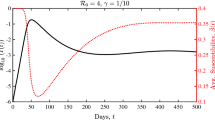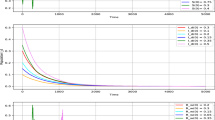Abstract.
We formulate compartmental differential susceptibility (DS) susceptible-infective-removed (SIR) models by dividing the susceptible population into multiple subgroups according to the susceptibility of individuals in each group. We analyze the impact of disease-induced mortality in the situations where the number of contacts per individual is either constant or proportional to the total population. We derive an explicit formula for the reproductive number of infection for each model by investigating the local stability of the infection-free equilibrium. We further prove that the infection-free equilibrium of each model is globally asymptotically stable by qualitative analysis of the dynamics of the model system and by utilizing an appropriately chosen Liapunov function. We show that if the reproductive number is greater than one, then there exists a unique endemic equilibrium for all of the DS models studied in this paper. We prove that the endemic equilibrium is locally asymptotically stable for the models with no disease-induced mortality and the models with contact numbers proportional to the total population. We also provide sufficient conditions for the stability of the endemic equilibrium for other situations. We briefly discuss applications of the DS models to optimal vaccine strategies and the connections between the DS models and predator-prey models with multiple prey populations or host-parasitic interaction models with multiple hosts are also given.
Similar content being viewed by others
References
Signore, C.: Rubeola, Primary Care Update for Ob/Gyns. 8, 138–140 (2001)
Francois, G., Kew, M., Van Damme, P., Mphahlele, M.J., Meheus, A.: Mutant hepatitis B viruses: a matter of academic interest only or a problem with far-reaching implications. Vaccine 19, 3799–3815 (2001)
Horikoshi, H., Kinomoto, M., Sasao, F., Mukai, T., Luftig, R.B., Ikuta, K.: Differential susceptibility of resting CD4+ T lymphocytes to a T-tropic and a macrophage (M)-tropic human immunodeficiency virus type 1 is associated with their surface expression of CD38 molecules. Virus Research 73, 1–16 (2001)
Nieto, A., Beraun, Y., Collado, M.D., Caballero, A., Alonso, A., Gonzalez, A., Martin, J.: HLA haplotypes are associated with differential susceptibility to Trypanosoma cruzi infection. Tissue Antigens 55, 195–198 (2000)
Willaims-Blangero, S., Vandeberg, J.L., Blabgero, J., Teixeira, A.R.L.: Genetic epidemiology of seropositivity for Trypanosoma cruzi infection in rural Goias. Brazil, Am. J. Trop. Med. Hyg. 57, 538–543 (1997)
Cleary, T.G.: Cytoxin-producing Escherichia coli and the hemolytic uremic syndrome. Pediatr. Clin. North Am. 35, 485–501 (1988)
Waterai, S., Yokota, K., Tana, Kishimoto, T., Kanadani, T., Taketa, K., Oguma, K.: Relationship between susceptibility to hemolytic-uremic syndrome and levels of globotriaosylceramide in human sera. J. Clinical Microbiology 39, 798–800 (2001)
Hyman, J.M., Li, J., Stanley, E.A.: The differentiated infectivity and staged progression models for the transmission of HIV. Math. Biosci. 155, 77–109 (1999)
Lin, X., Hethcote, H.W., Van den Driessche, P.: An epidemiological model for HIV/AIDS with proportional recruitment. Math. Biosci. 118, 181–195 (1993)
Thieme, H.R., Castillo-Chavez, C.: How may infection-age dependent infectivity affect the dynamics of HIV/AIDS? SIAM J. Applied Math. 53, 1449–1479 (1993)
Ahmed, E., Agiza, H.N.: On modeling epidemics. Including latency, incubation and variable susceptibility. Physica A 253, 347–352 (1998)
Bolker, B.M., Grenfell, B.T.: Chaos and biological complexity in measles dynamics. Proc. R. Soc. Lond. B. 251, 75–81 (1993)
Duncan, C.J., Duncan, S.R., Scott, S.: Whooping cough, epidemic in London, 1701–1812: infection dynamics, seasonal forcing and the effects of malnutrition. Proc. R. Soc. Lond. B. 263, 445–450 (1996)
Duncan, S.R., Scott, S., Duncan, C.J.: Modelling the different smallpox epidemics in England. Phil. Trans. R. Soc. Lond. B. 346, 407–419 (1994)
Hethcote, H.: The mathematics of infectious diseases. SIAM Review 42, 599–653 (2000)
Castillo-Chavez, C., Thieme, H.R.: Asymptotically autonomous epidemic models. In: O. Arino, M. Kimmel, (eds.), Mathematical Population Dynamics: Analysis of Heterogeneity, Vol. 1, Theory of Epidemics, Wuetz, 1995, pp. 33–50
Greenhalgh, D., Diekmann, O., de Jong, M.C.M.: Subcritical endemic steady states in mathematical models for animal infections with incomplete immunity. Math. Biosci. 165, 1–25 (2000)
May, R.M., Anderson, R.M.: Transmission dynamics of HIV infection. Nature 326, 137–142 (1987)
Dietz, K., Heesterbeek, J.A.P., Tudor, D.W.: The basic reproduction ratio for sexually transmitted diseases, Part 2. effects of variable HIV infectivity. Math. Biosci. 117, 35–47 (1993)
Diekmann, O., Heesterbeek, J.A.P.: Mathematical Epidemiology of Infectious Diseases. Wiley, New York, 2000
Hyman, J.M., Li, J.: An intuitive formulation for the reproductive Number for the spread of diseases in heterogeneous populations. Math. Biosci. 167, 65–86 (2000)
May, R.M.: Stability and Complexity in Model Ecosystems. Monographs in Population Biology 6, Princeton University Press, Princeton, New Jersey, 1974
Berryman, A.A.: The origins and evolution of predator-prey theory. Ecology 73, 1530–1535 (1992)
Arditi, R., Ginzburg, L.R.: Coupling in predator-prey dynamics: Ratio-dependence. J. Theor. Biol. 139, 311–326 (1989)
Gutierrez, A.P.: Physiological basis of ratio-dependent predator-prey theory: The metabolic pool model as a paradigm. Ecology 73, 1552–1563 (1992)
Hsu, S.-B.: Tzy-Wei Hwang, and Yang Kuang, Global analysis of the Michaelis-Menten-type ratio-dependent predator-prey system. J. Math. Biol. 42, 489–506 (2001)
Author information
Authors and Affiliations
Additional information
This research was partially supported by the Department of Energy under contracts W-7405-ENG-36 and the Applied Mathematical Sciences Program KC-07-01-01.
Rights and permissions
About this article
Cite this article
Hyman, J., Li, J. Differential susceptibility epidemic models. J. Math. Biol. 50, 626–644 (2005). https://doi.org/10.1007/s00285-004-0301-7
Received:
Published:
Issue Date:
DOI: https://doi.org/10.1007/s00285-004-0301-7




